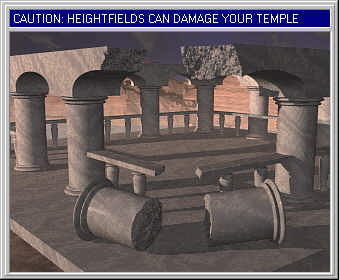

|
|
|---|
|
Heightfields in CSG-groups
· A very interesting thing is to use HFs in CSG-groups. Due to the fact, that you can stretch and scew a HF just as you like, you can use HFs easily to manipulate other drawing-primitives. For example - in the picture below a HF helped, to »damage« parts of the temple. 
· As shown in the picture, several HFs were used, to split the column and make a good and randomly looking breakage. Let's have a more detailed explanation: · Top-boxes and banisters: for these parts, you only have to load and scale the heightfields so that they fit. To cut out the parts with CSG, you certainly use a »difference«-operation. NOTE: it will help, if you scale the boxes X-values to somewhere near X=11.3 (ca.). |
The broken column
· This breakage is a bit more complex. Anyway - it's not too difficult to achieve a good-looking damaged column too. Just check out the following steps. Step 1 - take out one column of the temple (translate) and scale the shaft to a little bit less than half the original height (don't forget: you have to translate it again to a correct postion on the vertical axis afterwards). Step 2 - copy this cylinder so that you have two short shafts for the upper and the lower part of the column. Step 3 - select all parts of the column and rotate the whole thing in the front-view (+/- 90°). Step 4 - load and scale another HF and combine it with one half of the column using a »CSG-difference« (let the higher parts of the HF point into the shaft). Step 5 - for the other half of the column we have to do a bit more. First, copy the shaft again and scale the copy, so that its length is about 1/5th of the source- shafts length. Now move the copy to the end of the source-shaft so that these two parts overlap slightly, but be careful that you do not have any deviations along the Y- or Z-axis (use the TAB-key for this). Step 6 - create another HF, scale, rotate and translate it until it fits to the copy of the shaft and perform a »CSG- intersection«-operation - DONE !!! · If you want to gain an even more realistic look, than select one half of the columns inluding the HFs and rotate it a bit (see picture for demonstration). ·If you are still unsure, or don't know how to handle heightfields in the above mentioned way, then there's no need to weep: We've prepared a scene named »BROKCOL1.ZIP«, which you can download, by clicking here. |
| Chapter B/Page 5 |
|
Mail to webmaster:
support@povlab.org This page was last modified on: 1996-07-27 |
Mail to the author of the POVLAB-Tutorial:
lepschi@source.co.at |